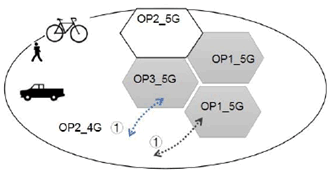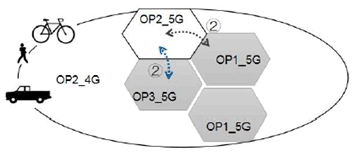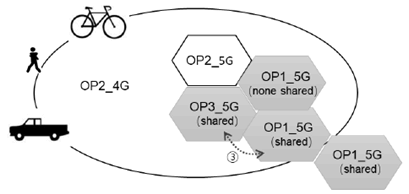Content for TR 22.851 Word version: 19.1.0
5.3 Use Case on Network Access Control and Mobility between Sharing Parties
5.3.1 Description
5.3.2 Pre-conditions
5.3.3 Service Flows
5.3.4 Post-conditions
5.3.5 Existing Features partly or fully covering Use Case Functionality
5.3.6 Potential New Requirements needed to support the Use Case
...
...
5.3 Use Case on Network Access Control and Mobility between Sharing Parties p. 13
5.3.1 Description p. 13
It is worth mentioning that 5G networks have been designed to be able to provide shared facilities from the beginning. This means that in the case that the 4G network has both non-shared and shared E-UTRAN at the same time, there could be a number of different types of coverage in the same region:
- Non-shared E-UTRA coverage,
- Shared E-UTRA coverage,
- Non-shared 5G NR coverage,
- Shared 5G NR coverage.
5.3.2 Pre-conditions p. 13
-
It is assumed that OP1, OP2 and OP3 has deployed 4G and 5G networks.
- Both OP1 and OP3 are Hosting NG-RAN Operators, which shared NG-RAN with participating OP2.
- UEs subscribe to OP2's home PLMN.
- UEs may register successfully to OP1 and OP3's shared 5G network.
- Both operators (i.e., OP1 and OP3) agreed to share their networks via indirect connection between the shared radio access network and the OP2's core network.
- Potential scenario1: The coverage of OP1 and OP3's shared 5G network may overlap with OP2's 4G network; may also overlap with OP2's 5G network (i.e., at OP1 and OP2's border, at OP3 and OP2's border).
- Potential scenario2: The coverage of OP1's shared 5G network may overlap with OP3's shared 5G network (i.e., at OP1's and OP3's border). Some parts of shared areas do not overlap the OP2's network. There are none-shared areas in OP1 or OP3 networks as well.
5.3.3 Service Flows p. 13
Mobility and access control scenarios in shared network are illustrated in the following:
- Scenario 1 (Figure 5.3.3-1a): a UE with a subscription from OP2 moves between OP2's own 4G access networks and either OP1's or OP3's shared 5G networks.
- Scenario 2 (Figure 5.3.3-1b): a UE with a subscription from OP2 moves between OP2's own 5G access networks and either OP1's or OP3's shared 5G networks.
- Scenario 3 (Figure 5.3.3-2): a UE with a subscription from OP2 moves between coverage of OP1's and OP3's shared 5G access networks.

Figure 5.3.3-1a: Scenario 1: a UE with a subscription from OP2 moves between OP2's own 4G access networks and either OP1's or OP3's shared 5G networks
(⇒ copy of original 3GPP image)
(⇒ copy of original 3GPP image)

Figure 5.3.3-1b: Scenario 2: a UE with a subscription from OP2 moves between OP2's own 5G access networks and either OP1's or OP3's shared 5G networks
(⇒ copy of original 3GPP image)
(⇒ copy of original 3GPP image)
1)
UE connects to the participating OP2_4G network then accesses to the hosting OP1_5G or OP3_5G network when the UE crosses the border between the shared network managed by hosting operators and the OP2's own 4G access networks in the scenario 1 (As shown as (1) in Figure 5.3.3-1a).
2)
UE connects to the participating OP2_5G network then accesses to the hosting OP1_5G or OP3_5G network when the UE crosses the border between the shared network managed by hosting operator and the OP2's own 5G access networks in the scenario 2 (As shown as (2) in Figure 5.3.3-1b).

Figure 5.3.3-2: Scenario 3: a UE with a subscription from OP2 moves between coverage of OP1's and OP3's shared 5G access networks
(⇒ copy of original 3GPP image)
(⇒ copy of original 3GPP image)
3)
UE connects to the hosting OP1_5G network then accesses to the hosting OP3_5G network when the UE crosses the border between the two shared networks managed by different hosting operators in the scenario 3 (As shown as (3) in Figure 5.3.3-2).
4)
The UE accesses the shared network via indirect sharing network method in the specific geographical area as OP1_5G (shared) and/or OP3_5G (shared) shown in Figure 5.3.3-2, based on the agreements between the hosting and the participating operators.
5)
The UE connects to an appropriate access network, when the user moves to an area where more than one operator's access networks provide connectivity, e.g., existing OP3's 5G network and the OP2's 4G network, or existing OP1's 5G network and OP3's 5G network, based on the agreement between the hosting and participating operators.
5.3.4 Post-conditions p. 15
All forms of mobility (i.e., between participating operators RAN and shared RAN for both CONNECTED mode and IDLE mode UE, see the clause 3.1 of TS 23.122) are successfully processed in a sharing scenario without direct connections between the shared access and the core networks of the participating operator.
5.3.5 Existing Features partly or fully covering Use Case Functionality p. 15
SA1 has performed various studies on mobility and network sharing in previous releases, where related normative stage 1 requirements are introduced in TS 22.101 and TS 22.261.
3GPP TS 22.261 introduces requirements of Diverse mobility management, stated as follows:
The 5G system shall support inter- and/or intra- access technology mobility procedures within 5GS with minimum impact to the user experience (e.g. QoS, QoE).
3GPP TS 22.261 describes various access related requirements, stated as follows:
Based on operator policy, the 5G system shall support steering a UE to select certain 3GPP access network(s).
3GPP TS 22.101 introduces requirements of mobility of network sharing, stated as follows:
It shall be possible to support different mobility management rules, service capabilities and access rights as a function of the home PLMN of the subscribers.
The above requirements are based on MOCN.
5.3.6 Potential New Requirements needed to support the Use Case p. 15
[PR 5.3.6-001]
In case of indirect network sharing, the 3GPP system shall support mechanisms to minimize service interruptions for UEs that are moving between different Shared RANs or between a Shared RAN and a non-shared RAN (managed by Hosting and Participating Operators).
[PR 5.3.6-002]
In case of Indirect Network Sharing and subject to Hosting and Participating Operators' policies, the 3GPP system shall support access control for a UE accessing a Shared NG-RAN.
[PR 5.3.6-003]
In case of Indirect Network Sharing and subject to Hosting and Participating Operators' policies, the 3GPP system shall be able to select an appropriate radio access network (i.e., 4G, 5G) for a UE.
[PR 5.3.6-004]
In case of Indirect Network Sharing and subject to Hosting and Participating Operators' policies, the 3GPP system shall support a mechanism to enable a UE with a subscription to a Participating Operator to access an authorized Shared NG-RAN.